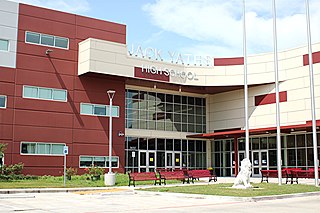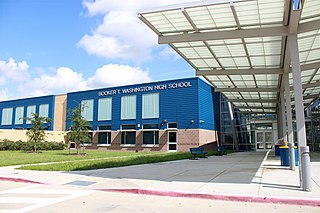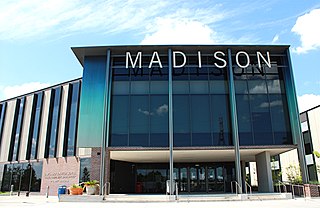
Bellaire High School is a comprehensive, public secondary school in Bellaire, Texas. Part of the Houston Independent School District, it serves the incorporated city of Bellaire, the Houston community of Meyerland, and other adjacent Houston neighborhoods. It has a racially and socioeconomically diverse student body.

Sam Houston Math, Science, and Technology Center (SHMSTC), formerly known as Sam Houston High School is a high school located in the Hawthorne Place and Timber Garden subdivisions, in Houston, Texas, United States. Sam Houston Math, Science, and Technology Center handles grades nine through twelve and is part of the Houston Independent School District. Before 1955, it was located in Downtown Houston.

Jack Yates Senior High School is a public high school located at 3650 Alabama Street, very near Texas Southern University, in the historic Third Ward in Houston, Texas. Yates High School handles grades nine through twelve and is part of the Houston Independent School District (HISD).

Heights High School, formerly John H. Reagan High School, is a senior high school located in the Houston Heights in Houston, Texas. It serves students in grades nine through twelve and is a part of the Houston Independent School District.

Westbury High School is a secondary school located in the Brays Oaks, of Southwest Houston, Texas, near the Westbury neighborhood. It has grades 9 through 12, and is part of the Houston Independent School District. In 2019, Jerri Nixon succeeded Susan Monaghan as principal, who had retired.

Westside High School is a secondary school in Houston, Texas, United States. It serves grades 9 through 12 and is part of the Houston Independent School District.

César E. Chávez High School is a secondary school located at 8501 Howard Drive in the Allendale neighborhood in Houston, Texas, United States.

Sharpstown High School is a secondary school at 7504 Bissonnet Street in Greater Sharpstown, Houston, Texas, United States with a zip code of 77074. It serves grades 9 through 12 and is a part of the Houston Independent School District.

Booker T. Washington High School is a secondary school located in the Independence Heights community in Houston, Texas. Washington serves grades 9 through 12, and is a part of the Houston Independent School District. The school has a neighborhood program that serves neighborhoods outside the 610 Loop and inside Beltway 8 in the northwest part of Houston, including the neighborhoods of Independence Heights, Highland Heights, and most of Acres Homes. The school was named after education pioneer Booker T. Washington.

Phillis Wheatley High School is a secondary school located at 4801 Providence Street in Houston, Texas, United States with a ZIP code of 77020. Wheatley is a part of the Houston Independent School District. Wheatley, named after Phillis Wheatley, is located inside the 610 Loop in the Fifth Ward.

James Madison High School is a public high school located in the Hiram Clarke area of Houston, Texas, United States. The school, located in the Five Corners District, serves grades 9 through 12 and is part of the Houston Independent School District. The school is named after James Madison, the fourth President of the United States.

Charles H. Milby High School is a public secondary school at 1601 Broadway in the East End, Houston, Texas, United States. It serves grades 9 through 12, and is a part of the Houston Independent School District.

Jones Futures Academy, previously Jesse H. Jones High School, is a public high school in South Park, Houston, Texas, United States. It has Dual Credit Magnet Program with emphasis in Health Sciences and Petroleum Engineering. Students who maintain the course of the entire program would graduate high school in May/June of their Sr. year and will have the ability to receive an associate degree in August following their graduation in one of their offered degree programs. Jones, which serves grades 9 through 12, is a part of the Houston Independent School District. Jones was named after Jesse Holman Jones.

Edgar Gregory-Abraham Lincoln Education Center (GLEC) is a K-8 school located at 1101 Taft in the Fourth Ward area of Houston, Texas, United States. Gregory-Lincoln is a part of the Houston Independent School District (HISD) and has a fine arts magnet program that takes students in both the elementary and middle school levels. Originally built in 1966 as Lincoln Junior and Senior High School, it later operated as Lincoln Junior High School until Gregory Elementary School merged into it in 1980, forming Gregory-Lincoln. The school moved into its current building in 2008; the rebuilding was delayed due to concerns that U.S. Civil War-era graveyards would be disturbed by the rebuilding process.

Ebbert L. Furr High School is a secondary school located in Houston, Texas, United States. Furr, which serves grades 9 through 12, is a part of the Houston Independent School District.

Ross Shaw Sterling High School, also known as Sterling Aviation High School, is a secondary school located in Houston, Texas. Sterling, which serves grades 9 through 12, is a part of the Houston Independent School District. The school was named after Ross S. Sterling. Sterling has Houston ISD's magnet program for Aviation Sciences.

Magnolia Park is an area of the East End, Houston, Texas, located near the Houston Ship Channel. One of the oldest Hispanic neighborhoods in the City of Houston, Magnolia Park was formerly incorporated as the City of Magnolia Park in eastern Harris County.

Kashmere High School is a secondary school in Houston, Texas that serves grades 9 through 12; it is a part of the Houston Independent School District. It is located in the Trinity Gardens neighborhood, and its namesake is the nearby Kashmere Gardens neighborhood.
Port Houston is a neighborhood located on the East Side of Houston, Texas, United States.



















